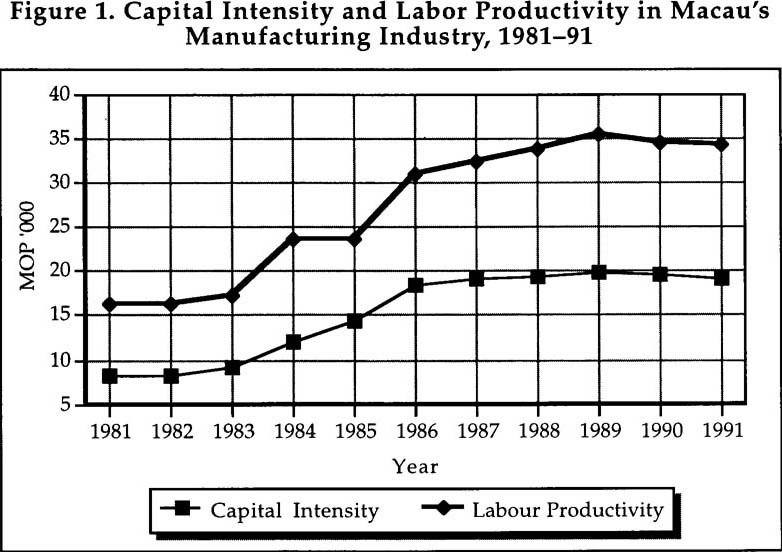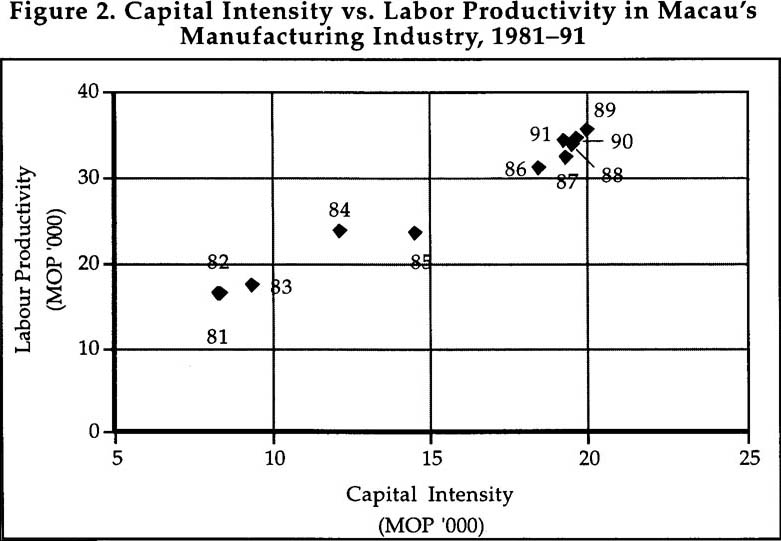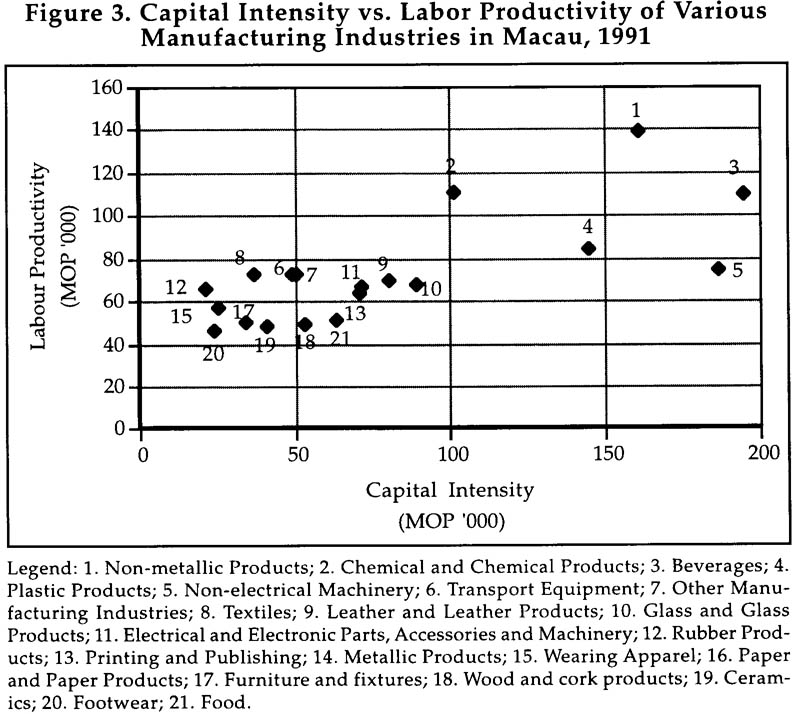Capital Intensity and Labor Productivity:The Case of Macau's Manufacturing Industry
Hon-Kong Tse(Faculty of social Sciences and Humanities University of Macau)
This paper attempts to find out the pace at which Macau's manufacturing indus-try has become more capital-intensive, and how this change is related to growth in labor productivity. During the 1981-91 period, Macau manufacturing be-came more capital intensive, but at very unsteady rates. The rate increased very slowly in the 1981-82 period, grew rapidly in the 1983-87 period, and stagnated in the 1988-91 period. Labor productivity changed in a very similar fashion. Capital intensity and labor productivity were found to be highly correlated in a longitudinal sense. In a cross-sectional sense, that is across various manufactur-ing industries, capital intensity and labor productivity seem to bear some weak non-linear relationship. For the manufacturing sector as a whole, Macau's labor productivity was 47% of its Hong Kong counterpart, and Macau's employees were paid 41% of their counterparts' compensation in 1991.
Introduction
It is no secret that Macau's industrial sector as a whole is in decline. Over the last few years, both industrialists and economists have repeatedly pointed out various interrelated problems facing Macau's manufacturing industry:
1. As a result of the opening of China and other East Asian countries where factor prices are much lower than Macau's, as well as because of Macau's rapidly increasing wages, rentals and other cost factors, Macau's industrial production has gradually shifted to other areas.
2. Macau's manufacturing processes have been largely labor- intensive and its industrial output has consisted mainly of low value-added products. This puts Macau in a very disadvantageous position in competing with East Asian nations where factor prices are much lower.
3. Poor education and inadequate training result in low labor productivity.
4. Macau's manufacturing production has been over-reliant on the textile and garment sector.
5. Macau's manufacturing exports have been overconcentrated on the USA and the European Community (EC) markets. As a result, economic recession or any change in import policy of these nations will seriously damage Macau's manu-facturing industry.
6. Markets of Macau's industrial exports are guaranteed by quota offered by devel-oped countries (mainly the USA and the EC) and the eventual removal of quotas will expose Macau to intense international competition that Macau is ill-prepared to face.1
The same group of economists and businessmen have also advanced their sug-gestions on reviving Macau's industrial activities. Their suggestions include: better education and training to improve labor productivity; change from labor-intensive production to capital-intensive production; production of goods of higher value-added identity, product diversification, market diversification, development of non-quota products, and in general, improvement of Macau's investment environment.
This paper does not attempt to provide solutions to the afore-mentioned prob-lems. Instead, it will consider empirically what actually happened to capital in-tensity (i.e. capital-labor ratio) and labor productivity (i.e., value-added per labor) of Macau's manufacturing industry during the 1981-91 period. The following re-lationships will be examined:
1. The longitudinal relationship between capital intensity and labor produc-tivity of Macau's manufacturing sector as a whole.
2. The cross-sectional relationship between capital intensity and labor pro-ductivity among various manufacturing industries in Macau in the year 1991.
It is hoped that the longitudinal study will shed light on the wisdom of ac-quiring more fixed capital to increase labor productivity, and that the cross-sec-tional study will provide useful information on the wisdom of industrial transfor-mation in a more capital-intensive direction in order to raise labor productivity.
In addition, as compensation is generally believed to be closely related to labor productivity (the higher the labor productivity, the higher should be the compensation), I shall draw a comparison between Macau's and Hong Kong's labor productivity and compensation.
Longitudinal Relationship between Capital Intensity and Labor Productivity, 1981-91
The growth of capital intensity and labor productivity of Macau's manufactur-ing sector during the period 1981-91 can be divided into three phases (Figure 1):
Period 1: Slow Growth (1981-82)
During this period capital intensity grew at a rate of only 0.3 percent per year. The sluggish growth in capital intensity can be accounted for by (1) the mass in-flux of new immigrants from mainland China, which provided Macau with an abundant supply of cheap labor, keeping wages at a stable level, and hence giving entrepreneurs little incentive to invest in fixed capital, and (2) an economic slowdown to Macau's major export markets such as the USA and the EC, which also discouraged investment in fixed capital. At the same time, labor productivity grew at the meager rate of 0.7 percent per year.

Period 2: Rapid Growth (1983-87)
During this period, economic recovery in the USA and the EC created very strong demand for Macau's manufactured products. At the same time, the open-ing of neighboring markets (such as Thailand, Malaysia, and particularly Main-land China) attracted a large amount of foreign investment into their manufactur-ing sectors. In comparison to Macau, these countries had lower wages and rentals, which put their labor-intensive manufacturing activities in highly competitive positions. In response, Macau entrepreneurs invested generously in fixed capital. As a result, capital intensity in Macau's manufacturing sector as a whole more than doubled during this period, from MOP9,344 per employee in 1983 to MOP19,310 in 1987, all measured in 1982 constant prices. At the same time, labor productivity grew at a phenomenal rate of 16.9 percent per year.
Period 3: Stagnation (1988-91)
June 1986 marked the commencement of Sino-Portuguese negotiations on re-turning Macau's sovereignty to China by 1999. Macau's political and economic future became uncertain. As a result, entrepreneurs in Macau were reluctant to invest in fixed capital. The trend was exacerbated by the slowdown of the US economy beginning the second half of 1989, which resulted in diminishing de-mand for Macau's manufactured products. In addition, at the end of 1990, the USA unilaterally suspended the import quota it had allotted for Macau's manu-factured products. In 1989 capital intensity peaked at around MOP20,000 per em-ployee and started to decline slightly in 1990 and 1991. Like capital intensity, labor productivity peaked in 1989 and started to decline slightly in 1990 and 1991.
The next task is to examine the empirical validity of the theoretical predic-tion that labor productivity should grow with capital intensity as each labor has an increasing amount of capital to work with. A casual examination of Figure 2 reveals the fact that, in general, labor productivity did grow with capital intensity in Macau's manufacturing industry. In fact, during the 1989-91 period, labor pro-ductivity did decline along with capital intensity.
A more precise examination of the relationship between capital intensity and labor productivity requires econometric analysis. In Figure 2, the way the points are scattered suggests that capital intensity and labor productivity may bear a linear relationship. Therefore, the following equation is tested:
LP = c + a (KL)
where LP = labor productivity
KL = capital intensity
c = constant of regression
a = coefficient of regression
Simple regression gives the following result:
LP = 3075 + 1.58 (KL)

The t-statistic for c=3075 is 2.57 and for a=1.58 is 21.09, which suggests that both terms are significant at the 5 percent level. The Durban-Watson statistic is 1.89, which indicates the absence of serial correlation, and R2=0.980 suggests that changes in labor productivity highly correlate with changes in capital intensity.
Cross-sectional Relationship between Capital Intensity and Labor Productivity,1991
While the longitudinal study of previous paragraphs may shed light on the wis-dom of acquiring more fixed capital to increase labor productivity, a cross-sectional examination of the relationship between capital intensity and labor productivity may provide valuable information on the wisdom of industrial transformation towards a more capital-intensive direction in order to raise labor productivity. From Figure 3, it seems that capital intensity and labor productivity do bear some weak non-linear
 relationship. In fact, the five most capital-intensive manufacturing industries (bev-erages, non-electrical machinery, non-metallic products, plastic products, and chemi-cals) are also the ones with the highest labor productivity.
relationship. In fact, the five most capital-intensive manufacturing industries (bev-erages, non-electrical machinery, non-metallic products, plastic products, and chemi-cals) are also the ones with the highest labor productivity.
Labor Productivity and Compensations: Macau vs. Hong Kong
In comparing the labor productivity of Macau and Hong Kong in 1990, it is found that with no exception Hong Kong's labor productivity in all manufacturing sectors is higher than its counterpart in Macau. Though the highest labor productivity in Macau's manufacturing industries is found in the beverage industry, with MOP135,043 of value-added per employee per year, the highest relative labor pro-ductivity belongs to the rubber products industry, where labor productivity is 85 percent of its Hong Kong counterpart. The lowest relative labor productivity is found in the tobacco industry where labor productivity is only 2 percent of its Hong Kong counterpart. For the manufacturing sector as a whole, Macau's labor productivity is only 47 percent of its Hong Kong counterpart (Table 1).
Compensation is generally believed to be closely related to labor productiv-ity. The higher the labor productivity, the higher should be the compensation. In comparing compensation per employee of Macau and Hong Kong in 1990, once again with no exception, Hong Kong's compensation per employee was higher than all similar Macau manufacturing sectors. Though the highest compensation in Macau's manufacturing industry is found in the transport equipment industry, MOP56,000 per employee per year, the highest relative compensation is found in the wood and cork products industry, where compensation is 63 percent of its Hong Kong counterpart. The lowest relative compensation is found, once again, in the tobacco industry, where labor productivity is only 12 percent of its Hong Kong counterpart. For the manufacturing sector as a whole, Macau's compensa-tion per employee is 41 percent of its Hong Kong counterpart.
Conclusions
As manufacturing activities gradually have moved away from Macau in the last few years, both industrialists and economists have repeatedly called for an industrial transformation. They feel that Macau's industrial sector should move in the following directions: (1) towards the production of higher value-added prod-ucts, (2) towards more capital-intensive production, and (3) product diversifica-tion. An important element in this industrial transformation is the improvement of labor productivity. It is believed that labor productivity can be improved by better education and training, as well as an increase in the capital intensity of industrial production.
As stated earlier, during the 1981-91 period Macau's manufacturing became more capital intensive, but at very unsteady paces. Capital intensity increased very
 slowly in the 1981-82 period, grew rapidly in the 1983-87 period, and stagnated in the 1988-91 period.
slowly in the 1981-82 period, grew rapidly in the 1983-87 period, and stagnated in the 1988-91 period.
To examine the wisdom of the suggested industrial transformation, we need to understand, among other things, the relationship between capital intensity and labor productivity. This paper examines both longitudinal and cross-sectional re-lationships between capital intensity and labor productivity in Macau's manufac-turing industry. It was found that longitudinally, capital intensity and labor pro-ductivity did bear a very close linear relationship - for every MOP1 increase in capital intensity, labor productivity will go up by MOP1.58. However, in a cross-sectional sense (i.e. across different industries), the (non-linear) relationship be-tween capital intensity and labor productivity is much weaker.
For the manufacturing sector as a whole, Macau's labor productivity was 47 percent of its Hong Kong counterpart, and Macau's employees were paid 41 per-cent of their counterparts' compensation in 1991.
Note
1 See for examples Ieong Wan Chong, "Characteristics of Macau's Economic Structure," Economia de Macau, Vol. 4. (1992) pp.3-7; Chong Hou, "Macau's Eco-nomic Transformation Should Have New Breakthrough, "Economia de Macau, (1992) Vol. 4.8-10; Yeung Eric, "Macau's Industrial Sector - Is There A Future?" Economia de Macau, Vol. 5. (1993) 29-36.




 relationship. In fact, the five most capital-intensive manufacturing industries (bev-erages, non-electrical machinery, non-metallic products, plastic products, and chemi-cals) are also the ones with the highest labor productivity.
relationship. In fact, the five most capital-intensive manufacturing industries (bev-erages, non-electrical machinery, non-metallic products, plastic products, and chemi-cals) are also the ones with the highest labor productivity. slowly in the 1981-82 period, grew rapidly in the 1983-87 period, and stagnated in the 1988-91 period.
slowly in the 1981-82 period, grew rapidly in the 1983-87 period, and stagnated in the 1988-91 period.